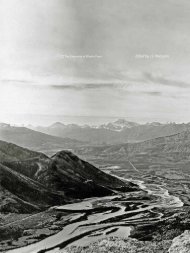C Ihe Ladies c cu. V'VVAN - History and Classics, Department of
C Ihe Ladies c cu. V'VVAN - History and Classics, Department of
C Ihe Ladies c cu. V'VVAN - History and Classics, Department of
- No tags were found...
You also want an ePaper? Increase the reach of your titles
YUMPU automatically turns print PDFs into web optimized ePapers that Google loves.
276 Notes to Pages 131-139usually awaits the foot that treads among rather than atophummocks. When thirteen men helped Lord Lonsdale crossthe Peel River Portage from Fort McPherson to La PierreHouse in September 1888, he found the hummocks "very verybad" (Krech, Victorian 69). The nrst day's trek westward on theportage had always elicited desperate descriptions from whitetravellers. Alex<strong>and</strong>er Hunter Murray was reminded <strong>of</strong> the'''Slough <strong>of</strong> Dis po nd'" (22) in Edmund Spenser's Faerie Queenewhen he spent IIJune 1847 wading his way westward throughthe hummocky-laden lowl<strong>and</strong>s <strong>of</strong> the Peel's drainage are. ElihuStewart, who crossed the portage inJuly 1906, included thisfeature in his description: "The grass grows in hummocksknown as tete defemme (woman's head). The trail is generallycovered with some water, <strong>and</strong> one is <strong>of</strong>ten tempted to try tostep from one to another <strong>of</strong> these tufts <strong>of</strong> grass, but as thesomewhat larger head rests on a slender neck you will soonprefer to wade along the narrow path, after perhaps having afew tumbles" (II7). Vyvyan saved her most interesting remarkon the vegetation for her letter to her mother <strong>of</strong> 3 August:"these are grassy tussocks with a 2 ft. drop between each, <strong>and</strong>usually they are too small <strong>and</strong> wobbly for you to hop along thecrests, so down you go up to the knee, also rather exhausting.How Gwen's ankle survived I don't know, but the AklavikDoctor turned her out <strong>of</strong> that plaster cast sound as a bell."CHAPTER 21: A DAY OF DAYS (15 JULY)The chapter's nrst three paragraphs amplify the quotation <strong>of</strong>Vyvyan's field note for I5July, <strong>and</strong> the sensation that thewomen were lords <strong>and</strong> conquerors appears only in the book.There are SOIne feelings too deep for tearsVyvyan here paraphrases lines from English Romantic poetWilliam Wordsworth's poem "Ode: Intimations <strong>of</strong>Immortality": "To me the meanest flower that blows can give IThoughts that do <strong>of</strong>ten lie too deep for tears."Loon Lake Inarks the Divide between Canada <strong>and</strong> AlaskaOn the <strong>Department</strong> <strong>of</strong> Mines <strong>and</strong> Technical Surveys' modernmap <strong>of</strong> the region-II6P, Bell River-Vyvyan's "Loon Lake" isnamed Summit Lake. Her choice <strong>of</strong> name likely comes fromSittichinli, for "Loon" is the direct English translation <strong>of</strong> theGwich'in name for the lake-Daadzaiivim (GSCI no. 13). Thepertinent aerial photographs <strong>of</strong> McDougall Pass are Ar7622-135, from the three forks <strong>of</strong> the Rat River on the east to LongLake on the west, <strong>and</strong> Ar7622-I33, showing Long Lake,Summit Lake, <strong>and</strong> the stream flowing westward to connect tothe Little Bell River (copies in Goering [33,35]). Of course,Vyvyan means that Loon Lake straddles, not the Divide betweenCanada <strong>and</strong> Alaska (one does not exist), but, rather, the Dividebetween the Mackenzie River <strong>and</strong> Yukon River basins, whichmarks the boundary between the Northwest <strong>and</strong> Yukon territories.CHAPTER 22: A GRIZZLY BEAR (16-17 JULY)As Vyvyan notes, it is only with the book's retrospection thatthe hunt becomes both "the most exciting experience <strong>of</strong> thewhole trip" <strong>and</strong> a shameful act. She could well feel shame forher own part-although her shot did not register-but herproprietary notion is misplaced. The desire for fresh meatcomes from the men, they kill the bear, <strong>and</strong> it provides themwith food for the trek back over the Peel River Portage to FortMcPherson; certainly, it is as much Gwich'in/Gwitchin river<strong>and</strong> country as it is an animal refuge. Vyvyan's subsequent use<strong>of</strong> the term "murder" seems a product <strong>of</strong> histrionic retrospection.Neither the sense <strong>of</strong> shame nor "murder" make anappearance in the field notes for 16 <strong>and</strong> 17 July; both tend tocontradict her published assessment: "as the days went by wewere filled with admiration for [Sittichinli' sl knowledge <strong>of</strong> wildlife which amounted to an almost mystical union with his owncountry" (99). The book alone includes her resentment <strong>of</strong> howhigh the men's wages are, although both field notes <strong>and</strong> bookpraise the men's work.Perhaps because Vyvyan's own field notes do not mentionwhen it was discarded, the lump <strong>of</strong> bear's meat stays with thewomen in the book much longer than it did in DorrienSmith's field notes: her entry for Sunday, I8July only the dayafter the men were paid <strong>of</strong>f, mentions setting <strong>of</strong>f from their"lovely" camp at I p.m., "leaving the sack <strong>of</strong> grizzly bear by theriver."American Margaret Murie, whose book <strong>of</strong> Alaskan travelsappeared a year after Vyvyan' s, travelled up the Por<strong>cu</strong>pine Riverwith her husb<strong>and</strong> <strong>and</strong> young baby <strong>and</strong> withJess Rust inJune1926, the previous month. Her published views contrast withVyvyan's: "At the mouth <strong>of</strong> the Coleen River, on the lush goose-
















